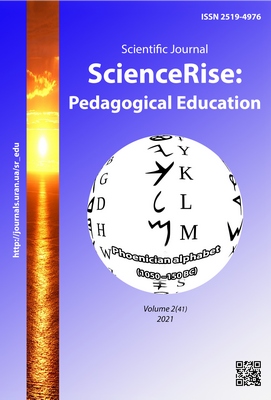Професійні компетенції студентів фізичної та математичної спецiальностей
DOI:
https://doi.org/10.15587/2519-4984.2021.228249Ключові слова:
професійна компетентність, науковий світогляд, міждисциплінарні зв’язки, критичне мислення, вища освітаАнотація
У статті окреслено питання професійної компетентності студентiв-старшокурсників фізичної та математичної спеціальностей. Наведена порівняльна характеристика їх професійних компетенцій, виявлені спільні та специфічні компоненти. З’ясовано, що у поєднанні з традиційними педагогічними методами навчання (що грунтуються на репродуктивній діяльності учня) важливим є впровадження новітніх методів, які предбачають надання особливої уваги формуванню фахових компетентностей випускників вузів. Обґрунтовано, що фізика нерозривно пов'язана з математикою. Математика дає фізиці засоби і прийоми загального і точного вираження залежності між фізичними величинами, які відкриваються в результаті експерименту або теоретичних досліджень. Тому зміст і методи викладання фізики залежать від рівня математичної підготовки. Показано, що викладання фізики та математики необхідно будувати на взаємному використанні елементів математики в курсі фізики і фізичних уявлень при вивченні алгебри і початків аналізу, адже це сприяє прискоренню розумового розвитку та формуванню наукового світогляду студента. Розкрито важливість міждисциплінарних зв’язків як складової міждисциплінарної інтеграції з метою оптимізації навчального процесу. Розглянуто питання можливостей створення фізико-математичної дисципліни та набору копетентностей якими повинні володіти їх майбутні фахівці. З’ясовано, для майбутніх фахівців такий підхід дозволяв би здійснювати освітній процес відповідно до вимог сучасного динамічного освітнього простору, набути нові навики роботи, бути більш конкурентноспроможними, але вводночас, через велику кількість розхододжень в компетенціях фахівців фізика та математика дана проблематика залишає за собою ряд методичних питаннь
Посилання
- Simaeva, N. P. (2010). Professional the competence of students of economic and legal specialities: the general and especial in the contents and formation conditions. Vestnik VolGU, 12, 50–59.
- Wong, A. Y., Daud, K. (2018). ICT Competencies among School Teachers: A Review of Literature. Journal of Education and Learning, 12 (3), 376–381. doi: http://doi.org/10.11591/edulearn.v12i3.5579
- Foxon, M., Richey, R. C., Roberts, R. C., Spannaus, T. W. (2003). Training Manager Competencie. ERIC Clearinghouse on Information and Technology, 177.
- Zhalinskii, A. E. (2009). Vvedenie v spetsialnost «IUrisprudentsiia». Professionalnaia deiatelnost iurista. Moscow: Prospekt, 368.
- Ostanina, S. A., Ptitsyna, E. V. (2019). Competence approach to teaching University students in conditions implementation of educational standards of the third generation. World of Science. Pedagogy and psychology, 5, 1–12.
- Febrianis, I., Muljono, P., Susanto, D. (2014). Pedagogical competence-based Training Needs Analysis for Natural Science Teachers. Journal of Education and Learning, 8 (2), 144–151. doi: http://doi.org/10.11591/edulearn.v8i2.216
- Rakov, S. A. (2005). Formuvannia matematychnykh kompetentnostei vypusknyka shkoly yak misiia matematychnoi osvity. Matematyka v shkoli, 5, 2−8.
- Neporozhnia, L. V. (2016). Methodical features of formation of natural and scientific competence of seniors at physics lessons. Zb. nauk. prats. Seriia: Pedahohika, 22, 96–99.
- Mantula, T. I. (2005). Integrirovannoe prepodavanie i mezhpredmetnye sviazi v istoricheskom aspekte i segodnia. Vіsnik Zhitomirskogo derzhavnogo unіversitetu, 21, 95–99.
- Csilla, D. T. Kompetenciákról általánosságban. Available at: https://gramontinternational.com/hu/kompetenciakrol-altalanossagban
- Zoltán, N. (2017). Közép-kelet európai generációk digitális kompetencia és biztonságtudatosság vizsgálatának eredményei. Hadmérnök, 12 (4), 159–172.
##submission.downloads##
Опубліковано
Як цитувати
Номер
Розділ
Ліцензія
Авторське право (c) 2021 Livia Mesarosh

Ця робота ліцензується відповідно до Creative Commons Attribution 4.0 International License.
Наше видання використовує положення про авторські права Creative Commons CC BY для журналів відкритого доступу.
Автори, які публікуються у цьому журналі, погоджуються з наступними умовами:
1. Автори залишають за собою право на авторство своєї роботи та передають журналу право першої публікації цієї роботи на умовах ліцензії Creative Commons CC BY, котра дозволяє іншим особам вільно розповсюджувати опубліковану роботу з обов'язковим посиланням на авторів оригінальної роботи та першу публікацію роботи у цьому журналі.
2. Автори мають право укладати самостійні додаткові угоди щодо неексклюзивного розповсюдження роботи у тому вигляді, в якому вона була опублікована цим журналом (наприклад, розміщувати роботу в електронному сховищі установи або публікувати у складі монографії), за умови збереження посилання на першу публікацію роботи у цьому журналі.









